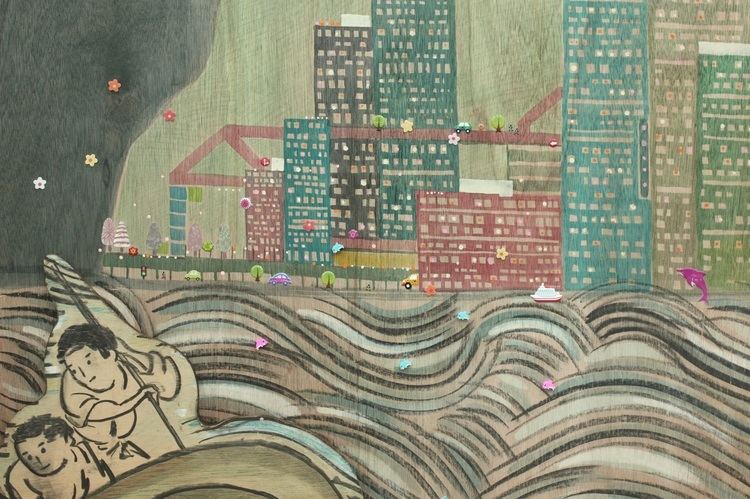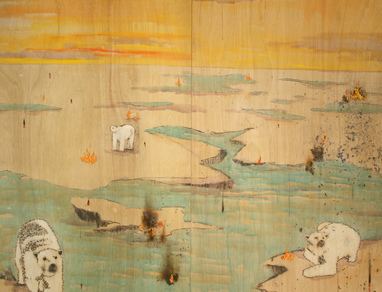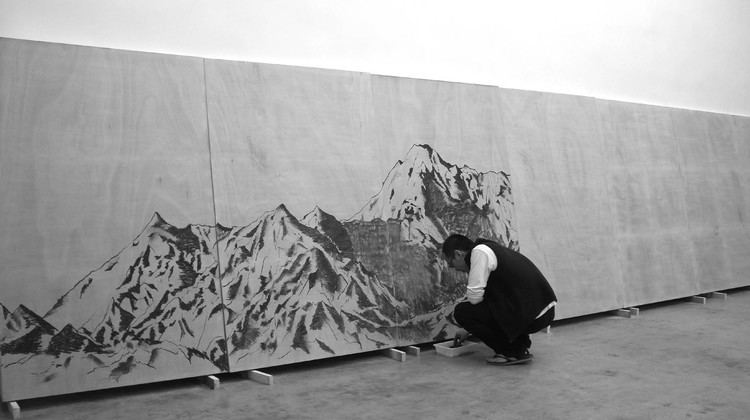Native name 林東鵬 Name Lam Pang | Role Artist | |
Education Bachelor in Fine Arts at CUHK, Master of Arts degree at Central Saint Martins College of Art and Design Known for Large-scale paintings and unconventional painting methods. Notable work Past Continuous Tense, Landscape of Travel and Leisure , The Huge Mountain, Antique series, Polar Bear series etc. Awards Young Artist of the Year (Hunting Art Prize), Best Artist in Visual Arts (Hong Kong Arts Development Awards) etc. | ||
v artists in the neighbourhood scheme v works by lam tung pang
Lam Tung Pang (Chinese: 林東鵬) is a Hong Kong artist. He was born in Hong Kong in 1978 and currently lives and works in London and Hong Kong. As one of the founders of Fotanian, his works are mostly related to specific situations collective memory, social contents and some of them are in monument scale by given a touch of humanity.
Contents
- v artists in the neighbourhood scheme v works by lam tung pang
- Lam tung pang prudential eye awards 2014
- Early Life and education
- Pursuit of Dream
- First Studio
- Studying in London
- Observation
- Environment
- Determination
- Exhibitions
- Awards
- References
Lam uses both traditional (oil, acrylic, charcoal, pencil) and non-traditional (nails, sand, plywood) materials to produce his pieces. He explores the relationship between objects and materials.

Lam tung pang prudential eye awards 2014
Early Life and education

Lam loved painting since he was a child and artistic creation has always been his goal. But he has encountered many hurdles on his creative journey. From his first dedicated efforts to the realisation of his dreams, Lam's story, as he has pursued his art, is an inspiration for the next generation.
Pursuit of Dream

Lam Tung Pang has loved drawing since he was a kid when he simply copied the cartoons he saw and did his best to reproduce them.
From secondary school to college, Lam had a very simple aim which was to study the subject that interested him most. But when he was filling out his application forms for college and choosing art as his major, his family suggested that he should take other majors like architecture because it also involved some art. Lam attempted to tell his family many times that it was not like that, but his family would not accept it. One day, Lam got so mad that he walked away. Lam knew that what interested him could only be found in art, so he chose to study art. His family was worried about how hard it is to earn a living as an artist, but Lam still decided to study the subject that engaged him most. Therefore, he chose the Fine Art Department.
Lam finally managed to convince his family and he was accepted by the Fine Art Department of Chinese University of Hong Kong and graduated in 2002. With his work ethic and resilience, Lam keeps working on art.
First Studio
Lam Tung Pang found difficulty to be creative, as he had to be very proactive during his college years. 'Even when no one gives you a topic, you have to come up with something out of nothing', said Lam. For Lam Tung Pang, the most difficult part was managing his time, so his second year at college, he really wanted to escape the bounds of his college. He wanted to control his own pace since he knew that when he graduated, he would no longer have his college as his locus. 'What would I do in the future? Actually, no one cared. There are a lot of possible paths or you can just wander aimlessly', said Lam.
It was then that Lam rented a place as a studio in Fo Tan with friends. He consciously set about making art his career at that time.
Studying in London
After graduation in 2002, Lam Tung Pang's focus remained on creating art.
In 2003, he decided to leave Hong Kong on a scholarship to study for a Master of Arts degree at Central Saint Martins College of Art and Design in London and completed the degree in 2004. This was his toughest time as he had to stay in a friend's living room. but he regards it as the most valuable experience ever. He did not do part-time job because he preferred to live simply not to waste time and money so that he could have full control of his time.
Lam Tung Pang used up all of his funding by his second year in London. It was a tough period but he had the greatest freedom at that time. With the luxury and freedom of time, Lam could see different things. That period was very valuable to him.
Lam's focus on his artistic creation finally saw him achieve his goal. In 2005, Lam became the first Chinese artist to win the Hunting Art Prize in the UK. He is also one the few Hong Kong artists to have exhibited at the Tate Modern, an internationally acclaimed modern art museum.
Lam won further recognition in 2009 when he was a winner at the Hong Kong Contemporary Art Biennial Awards.
Observation
Lam Tung Pang's works are based on his observations of his surroundings.
When he was in London, Lam visited local museums to see the originals of works of art he had seen in textbooks. Back in Hong Kong, he re-thought how to integrate his creative work in his surroundings in order to establish a closer relationship. He discovered that Hong Kong has a wealth of creative work and artistic resources. He was inspired to explore Hollywood Road in Sheung Wan and the Hong Kong Heritage Museum in Shatin and to look at ancient pottery statues there and this led him to develop his "Antique" series.
Environment
Lam's various collections, whether re-imagining the living environment of the population or as a metaphor for his own environment or as an exploration of the ultimate urban existence, all demonstrate Lam's endless search for the ideal way to live.
Lam expresses his observation and concerns in his works regarding environment, life and culture. Lam has created a lot of works about polar bears because he wants to use the image of the polar bear to compare its situation with ours. Polar bears are trapped in a space that does not belong to them, or their living space is being taken over or changes by other people or factors. Lam believed that the state of being a polar bear could be very similar to the environment that each of the individuals lived in.
Determination
‘Lam Tung Pang is always straining at the leash and very determined', said Chow Chun Fai, a Hong Kong artist and a friend of Lam. 'If he sets himself a goal, he will put up with any hardship to achieve it. And sometimes he'll do it in the hard way even when he knows there's an easier way', Chow said. Lam thought that his personal dedication could affect his lifestyle and something surprising or non-essential could happen which can be a response to his creative works. His determination drives him forward.
For instance, Lam insists on using plywood and he spared no efforts to study what coating material should be applied to the wood so that he can continue to use this fragile material in his work. Actually, Lam tried painting on canvas but the paint on the canvas made it too rigid. He thought that the colour only lied on the surface. But colour could permeate wood and highlighted the grain.
Exhibitions
Lam Tung Pang has exhibited worldwide and has worked in both private and public collections, including Deutsche Bank, Hong Kong Museum of Art and work commissioned by the Legislative Council of Hong Kong.
Exhibitions
Play, Espace Louis Vuitton Hong Kong in 2014
In PLAY, Lam utilises toys to create large-scale paintings and installations. Toys often reflect the "utopia" of a child's mind, however for adults the perspective is often complicated through accumulated life experiences. This in turn affects the adult cognitive processes when approaching toys, and it is this very act that Lam seeks to address in this exhibition. Featuring all new works, the exhibition will run from 9 May to 30 September 2014.
“Toys allow us to understand the constructs of learning," Lam states. As toys are among the first things that appeal to children's senses, their choice of toys can be seen as a documentation of their learning process. However, when adults play with toys, the complexity increases, with the added burden and benefit of personal histories and memories. It is this experience that elevates the toy from a child's object to a symbol of knowledge accumulation. Lam seeks to pose questions about artistic and creative processes through the act of playing.
The use of toys as an artistic medium has been a part of Lam's practice for some years because "playing" is an indispensable element to the artist's creation. Experimenting and toying with the assemblage of objects constitute a large part of his work. However, in PLAY the focus is on the toy for the first time, and represents a revolutionary advancement in Lam's oeuvre.
The exhibition highlights Lam's fascination with and study of materials. The artist collects toys from his private domestic environment as well as travel journeys. Curating a miniature museum that documents our systems of learning, the exhibition space features toy installations, that are a result of highly personal encounters. Playing with these found objects raises questions about growth, human experiences and the development of the adult mind, ideas which provide continuous inspiration to the artist.
Long View Under Scrutiny, Hanart TZ Gallery, Hong Kong in 2011
Developed as an extension of the Diorama series presented in 2010, Long View Under Scrutiny exhibits new work that continues Lam Tung-pang's reflection upon self and environment. Investigating a culturally acquired perception of memory in comparison to reality in this exhibition, Lam Tung-pang placed one of his most personal and iconic works, Folding (2006), a self-portrait within a hinged wood box created during his four years living in London, alongside his most recent creations, including The Youngest and the Oldest (2011), a five-panel work on plywood completed in his Fo Tan Studio.
The juxtaposition of these two artworks illustrates the arc of the artist's versatility and imagination, which is manifested within and beyond himself to society and its cultural context. The most intriguing aspect of this exhibition is witnessing how Lam Tung-pang illustrates this sense of identity through a conscious turn of mind and direction. If Folding exemplifies a curious but protective individual displaced from home, then The Youngest and the Oldest represents a harmonic disjunction in form and substance that maps out his anxiety about the present. The gulf between these two bodies of work indicates Lam Tung-pang's transformation from a conceptual artist to a cultural translator who visualizes today's Hong Kong in a post-1997 and pre-2047 era, the latter year marking fifty years after the handover of Hong Kong to China.
Awards
Lam Tung Pang is the first Chinese to win the Hunting Art Prize.
